
Friday March 22, 2019
By Laird Borrelli-Persson
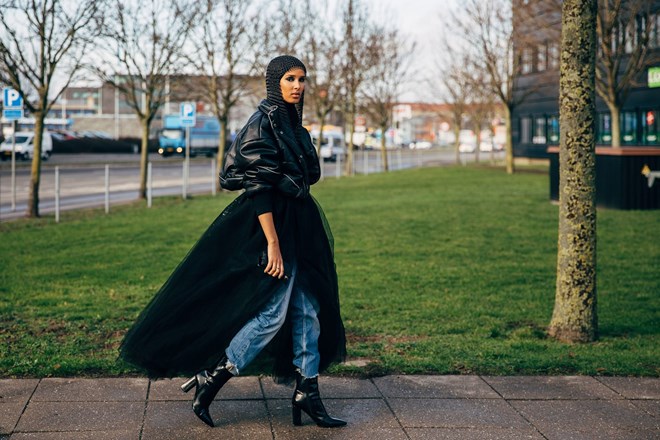
At Copenhagen Fashion Week [I wanted] to push my boundaries to see if I could still be fashionable when it was very cold and I still had to do all the layering. [Here I’m in a] chainmail medieval armor hood with a tulle skirt. I added the bomber jacket to make it look more urban. Photographed by Acielle / Style du Monde
As a number of designers were heralding a return to glamour on the runways this season, Rawdah Mohamed,
a 27-year-old Somali influencer living in Norway, was delivering it on
the streets in the form of face-framing feathers, dramatic eyewear, and
even a medieval-style mesh snood, all of which she wore with a hijab.
Grandeur suits Mohamed, a healthcare professional working with autistic
children, who can trace the start of her international street style
career back to last August when she attended Oslo’s Spring 2019 season;
between shows, she found time to sign as a model, due to her striking
features and unconventional style. Mohamed was active on Instagram
before that, though, followed mainly by modest-dressing Muslim women who
were intrigued by her ability to take readily available pieces—from
H&M or Zara, say—and pair them chicly in what she calls an East-West
mix.
Mohamed’s foray onto the international show circuit has not
been easy; Paris did not reveal itself as a City of Light to this
influencer, attending the shows there last month for the first time.
From negative body language to the intense scrutiny she received for
entrance to shows, despite carrying an invitation in hand, Mohamed
discovered that discrimination remained rampant, even with the strides
that have been made in terms of diversified casting. “I really wanted
[fashion] to be a place where I could just be myself and everyone would
just accept me for who I am,” she says. “I was very sad to realize that,
no, this is yet another place where I still have to fight to be me and
to be able to free to dress however I like and to look however I like.”Mohamed,
who has worn a hijab since she was about 7 years old, has been fighting
this fight since she moved to a small town in Norway. The bullying she
was subjected too, however, only strengthened her resolve to wearing the
hijab. “I never really liked the idea of having to adjust the way I
speak or the way I look just because it makes other people
uncomfortable,” she says. “I just continued wearing it and it sort of
became my shield and something I was proud of.” In so doing Mohamed has
unintentionally become a role model—an exemplar of a modern day Muslim
woman wearing fashion clothes. For Mohamed, the hijab is a form of
expression, not oppression. “I’m definitely using it to make a statement
that, yes, I’m a Muslim woman, I’m doing this, and you guys have to
deal with it—just like I was using it when I was a kid growing up with
my hijab. I feel like I’m doing the exact same thing with fashion. Deep
down I’m hoping [by my doing this] it will be easier for other girls.”
Here, Mohamed speaks to Vogue about her unabashed love of glamour and fighting for real inclusivity in the fashion world.
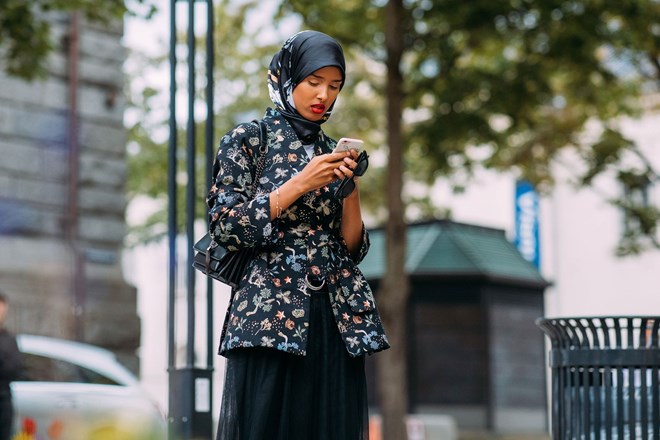
In Oslo in the coolest blazer from H&M, desperately asking if my babysitter can stay for two more hours. Photographed by Acielle / Style du Monde
When did you start wearing a hijab?
I’ve
been wearing it since I’ve been a first-grader, I think. I used to wear
it back in [Somalia] and I wore it when I came to Norway. I’ve never
taken it off. I didn’t think much of it because in my home country
everyone was wearing it, it was part of the uniform so you didn’t really
think much about it. The only ones that were not wearing it were the
Christians, so it was just like, ‘Okay, this is what we do.’
What was the reaction to your hijab in Norway?
Norway
is a small country and I came to a very small town. Because of my hijab
and because of my skin color—we were the few black people in the
community, and you know some of my classmates had never seen black
people before—so it was very, very difficult and obviously there was a
lot of bullying but I think [that] made me continue to wear it. The
adults in my life were saying, ‘If it helps with the bullying maybe you
can take it off, or maybe you can wear it in a different style that’s
not as covering,’ but I didn’t want the bullies to win. I didn’t want
them to have such power over my life.
I used to think, Why do I have to change? I’m not telling them to
change. You know, I think they look weird but that’s fine, I look weird
to them, too. I never really liked the idea of having to adjust the
way I speak or the way I look just because it makes other people
uncomfortable. I can’t change the way I look, even if I take off my
hijab, I’m still black and you know I can’t change that. So then what? I
just continued wearing it and it sort of became my shield and something
I was proud of. I had all this pressure, [people] were telling me,
‘This is not good enough. This is not how we want you to be,’ and I kept
wearing it and it just became part of my identity, it was who I was and
everyone just had to deal with it.
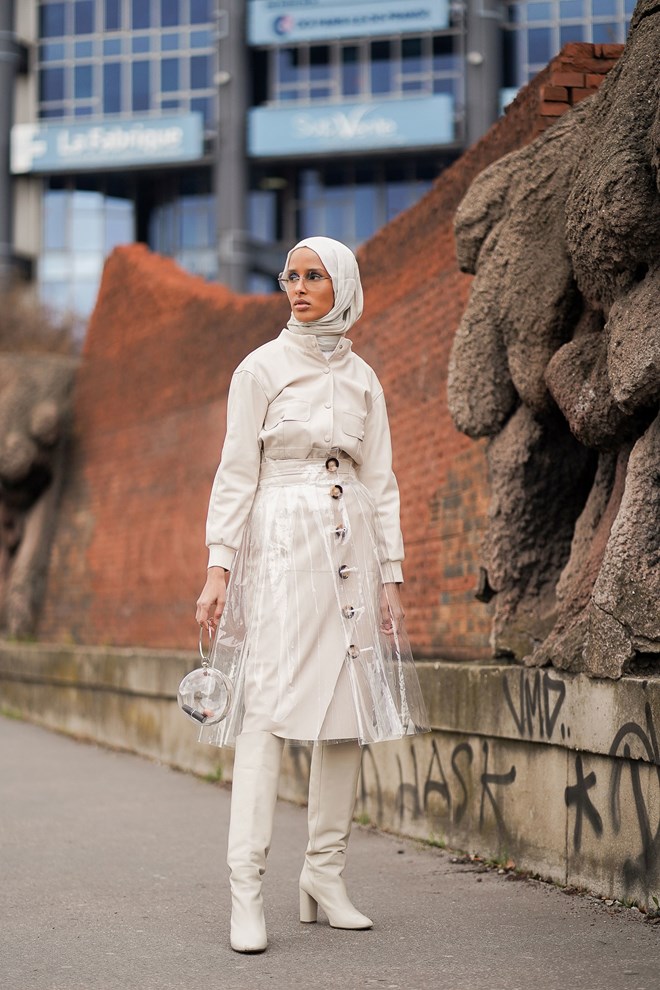
In Paris in a transparent asymmetrical skirt by Deat on top of a two-piece jacket and skirt, and a transparent ball-shaped bag. Photo: Ludovic Pieterson / Courtesy of Rawdah Mohamed
How would you describe your style?
I think I would
say, modern, modest, and maybe a little bit daring. I want my style to
be something a little out of the norm, especially when it comes to my
hijab. That’s what I was trying to do this season, I didn’t want it to
just be plain [and] boring, I wanted to add headpieces to my hijab to
make it more fashionable. I wanted to make it more like an art. That’s
how I found the medieval headpiece and other hats and all those things.
When people look at me the first thing they notice about me and my
identity is my hijab, so I thought, okay, this is what every
photographer is going to capture, this is what’s going to be in the
pictures, so I wanted to build my outfits around the headpiece for this
season.
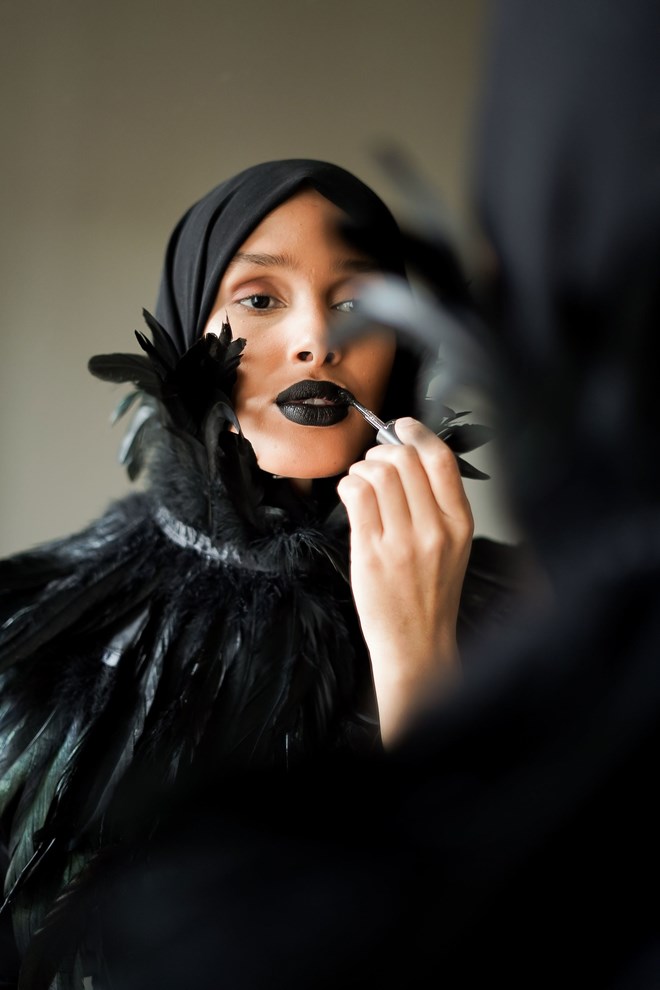
Putting on my game face: There’s nothing some black lipstick can’t fix. Photo: Ludovic Pieterson / Courtesy of Rawdah Mohamed
Glamour was a talking point of the Fall season and you really delivered it. How do you work it into your look?
Modest
dressing is always portrayed as something boring [and it can be]
difficult to add glamour to it because sometimes there’s no shape to
whatever you’re wearing and layering makes it even harder. Glamour
forces you to work with whatever you have; it’s a bit tricky but I love
that challenge and I loved seeing it on the runway because now I have
all this inspiration, now I have something that I can work on and it’s
something that is available to me now.
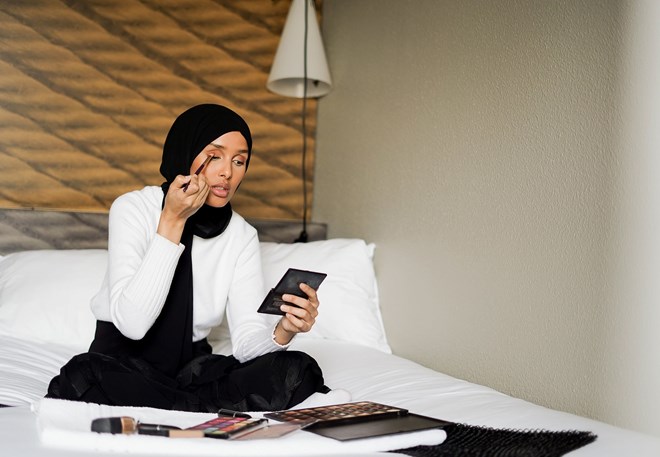
With each outfit change there is also a makeup change. Go big or go home. Photo: Ludovic Pieterson / Courtesy of Rawdah Mohamed
You’re also very interested in beauty….
I taught
myself how to do my makeup. I grew up in a small town there weren’t any
foundations in my color. When my aunties who live in America came to
Norway for holiday, they used to bring us [some]. Now there are all
these brands that [provide products for a broad range of skin tones] so
now I can become more like an artist. It’s not as limiting as it used to
be before and for me that makes it much more fun, you know I like to do
the colors, do the glitter…. I want [my look] to be the way I
envisioned it; I don’t want it to be less because the makeup brands are
not making makeup for me. But now I feel very lucky to have all these
brands that [do and] I like to take advantage of it. I think because
I’ve been waiting for it for so long, now that I have the opportunity, I
sometimes go all crazy because I’m very excited about it.
Can you talk about layering in terms of modesty and Scandinavian style?
It’s
very cold here most of the year so you have to add some layering into
it [your style but] for me it’s mostly about modesty. If I buy a long
maxi skirt, it usually has a split to the side, and not actually quite
what I’m looking for in my modest dressing, so sometimes I have to add
jeans or wide-legged pants underneath to cover the split, or I would
have to sew in the split. I live in Scandinavia and I’m obviously
interested by the style here, which I also love, so I think I’m lucky
because I can do the Scandi style, which is in the stores here, and I
can still do modest.
Do you incorporate any Somali dress traditions into your wardrobe?
Not
[so much] the actual clothes. I’m African, and you know we are very
colorful in our cultural clothes; I like to [wear] colors because of my
heritage. [I might choose] an orange hijab, or if I can find a
cultural print, I like to do that with the hijab. I do those looks more
in the summer than in the winter. We have this dress called dirac; we
wear it when we go to weddings and if there’s a festival because its
very glamorous. I had some shiny silver [Dirac fabric] made into a skirt
[that I wore in Paris with] a black denim miniskirt on top. I had to
tone it down it a bit because the skirt is very glittery, a bit too much
and I was wearing that as a day look.
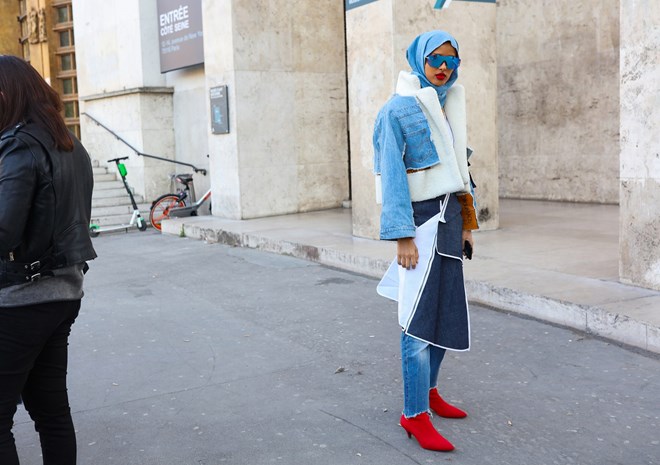
A full-on denim look in Paris. I’m wearing a skirt with an irregular hem with a denim jacket from Shengpalae, which is a Korean brand, and snowboard sunglasses. Photographed by Phil Oh
How did you start blogging?
I just wanted to
capture my outfits because they were so different. My page was private
[at first]. My friends were encouraging me to go public just to see how
the feedback would be from people who didn’t know me and so at the end
of 2016, or maybe even the beginning of 2017, I made it public and then
from then on it kind of just grew. Most of the followers I had at the
beginning were Muslim girls and they liked the fact that I was using
Western clothes, the stuff that you buy from the shops here, and making
them more modest; kind of like how East meets West.
[I’m a] modern
day Muslim woman wearing the fashion clothes that are in the the
magazines and that are trending. I think Muslim women appreciated that
because then they had something to look at because they were not getting
that from campaigns and magazines and other online sources. They would
ask me, ‘Where did you get this coat?’ And I would say I just got it
from my local store, and they would go buy it. It just sort of gave them
an idea of how to style the clothes that were actually available for
them and not something that was shipped from their home country or the
stuff they usually get when they are on holiday. I was using the clothes
that were selling in Norway and that I would buy from London that were
accessible for everyone to get.
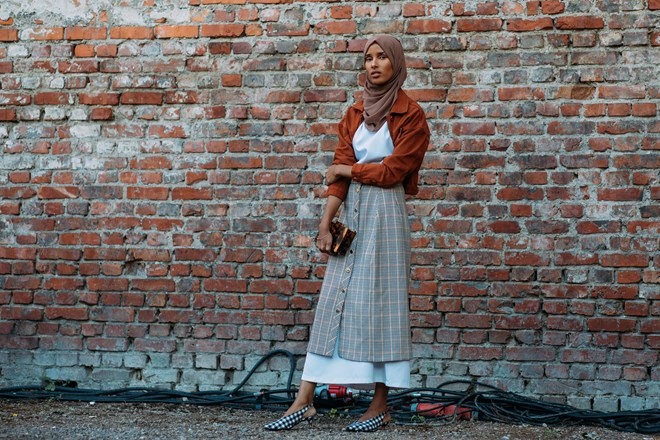
Me attending a fashion show for the first time [in Olso]. I was a bit shy and I didn’t know if I could truly do it the way I wanted to do it. I didn’t know if I could be the optimal version of me. Photographed by Acielle / Style du Monde
What was the tipping point in your social career?
I
think definitely the turning point was when I did Oslo Fashion Week
[Spring 2019] because then I entered the Western world of fashion;
before it used to be women in Africa, Asia, or the Arab countries who
were my following. When I Went to Oslo Fashion Week that’s sort of when I
introduced myself to the Western world. That’s when I met my manager.
When I first [signed], it was for modeling. I told them, ‘Modeling is
fine, but I also want to sign with you as an influencer as well. I think
it’s Oslo Fashion Week that made it happen for me. Photographers and
people in fashion were coming up to me and giving me compliments, that
was really good for me because [it was my] first time and I was a bit
shy and I didn’t know if I could truly do it the way I wanted to do it.
I didn’t know if I could be the optimal version of me. I was just
testing it and I tried to be a little more daring when I went to Copenhagen Fashion Week [for Fall 2019].
[Now] I have a lot of people who are not Muslims who are following
me. I think it has something to do with the fashion week. I attract
other people who also dress modestly. I have a lot of following from
American Christian communities who are not Muslims but wear modest
clothes. I [also] have all these people now asking me stuff basic stuff
about being a Muslim. What makes me really happy is to see that other
people—not just from my country or my religion—[following me] because
want my account to be for everyone not just for certain people.
Are you a role model?
I
don’t consider myself to be it, but I know I am; that’s what my
followers are telling me and that is something I have to be considerate
of when I dress because I just wear in whatever I like and what’s in my
style, I don’t think much about how this is going to influence other
people.
Can you talk about your first Paris Fashion Week?
Discrimination
is something that always happens to me in my daily life. Now being in
the fashion scene, a place where you know everyone is creative, I was
hoping that people would be more open minded and more accepting of other
ethnicities, other religions, and the way other people dress. I was
hoping that it could be a place of escape for me. So it was a little bit
of a shock to see the reaction, although I feel like I should have
known. I was in denial, hoping for the best and when I got some of the
reactions that I did I was very disappointed because I really wanted
[fashion] to be a place where I could just be myself and everyone would
just accept me for who I am. I was very sad to realize that, no, this is
yet another place where I still have to fight to be me and to be able
to free to dress however I like and to look however I like.
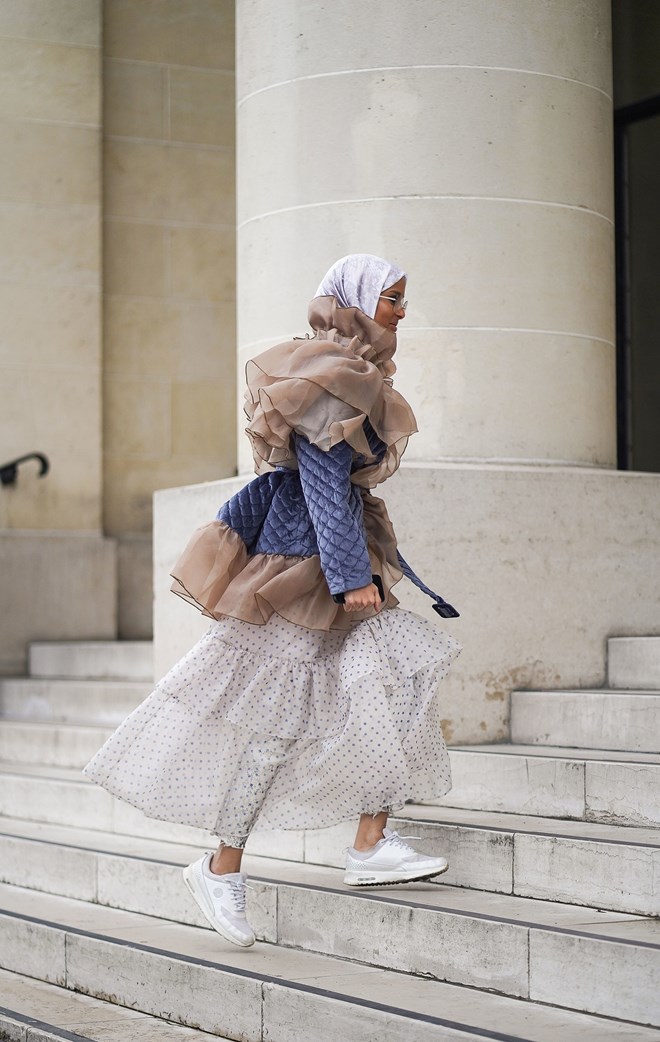
I’m forever late and always on the run. Photo: Ludovic Pieterson / Courtesy of Rawdah Mohamed
What kind of behaviors?
It can be body language
or, for instance, when you’re going into a show they would double check
your invitation and make you stand on the side while other people are
coming in and they’re not checking their invitations as much. It’s like
you have the exact same invitation, [and] your name is on it. Sometimes
they would ask for your ID and nobody else needs the ID but they need to
double make sure that you are who you are who you say you are, and
sometimes they would check your ID and your name and they would call
another person or their manager or whoever it is to double check that
info again. Or it can just be simple things, as when you go up to order
a drink or whatever, and you’re being ignored. It’s all these things
that are very unnecessary. You know, it’s the small things you pick up
during the whole day at every fashion show and at the end it just gets
very exhausting.
What are your thoughts on diversity, or the lack of it, in street style?
I saw that Teen Vogue was doing a story on diversity
for Paris Fashion Week. I read the article and I think that was really
good. It was a very positive thing to see and it sort of gave me hope in
the very hopeless situation I was in. I kept coming across all these
negative comments and people’s behavior so to see that was like a light
in a dark moment so I really appreciated that.
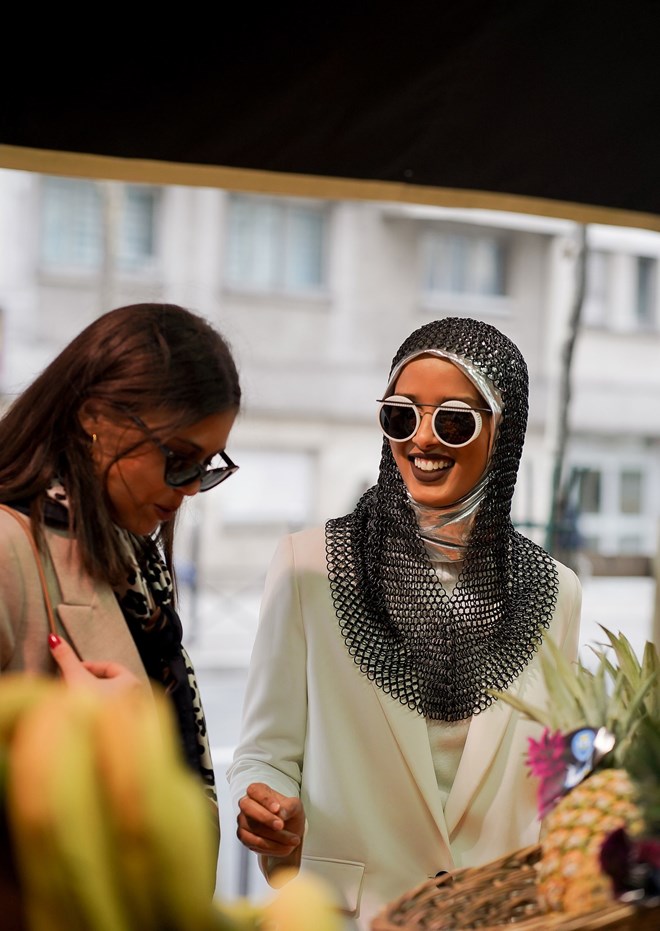
Here I am just casually laughing at my own dry jokes while my French friend Shymene just wants to buy her fresh fruits in peace. Photo: Ludovic Pieterson / Courtesy of Rawdah Mohamed
You’ve said that the media usually portray Muslim women as
oppressed and without a voice. It seems that you are using your hijab as
a form of free expression. Would you agree with that assessment?
Yes,
definitely, definitely. People make us feel like we don’t belong, and I
think the way for me to use fashion is [to say]: ‘I’m here, and I’m
here with my hijab, and I belong here as much as you guys do, I deserve
to have the same opportunities as you.’ When I speak with other
bloggers, they don’t have to worry about these things. They’re allowed
to enjoy fashion week, they’re allowed to come and just be themselves
and no one is questioning them and nobody’s making them doubt
themselves. And so I’m definitely using it to make a statement that,
yes, I’m a Muslim woman, I’m doing this, and you guys have to deal with
it—just like I was using it when I was a kid growing up with my hijab. I
feel like I’m doing the exact same thing with fashion.
Deep down I
think I’m hoping [by doing this] it will be easier for other girls to
dress however they want and be whoever they want without having to go
through what I went through, just like other women in the past have
worked hard and have gone through the harshness just so we can vote or
so we can have an education. I mean I’m not as great as them, but if
there’s any way that I can help the next generation then of course [I
want to do that]. Thinking about something that is much bigger than me
and the way I want to dress helps me stay positive. It’s about the women
who are coming after, and for me that makes it very easy to deal with
the negatives. I think this is just a small sacrifice that I have to do,
the picture is much bigger, and that gives me hope.
This interview has been edited and condensed.